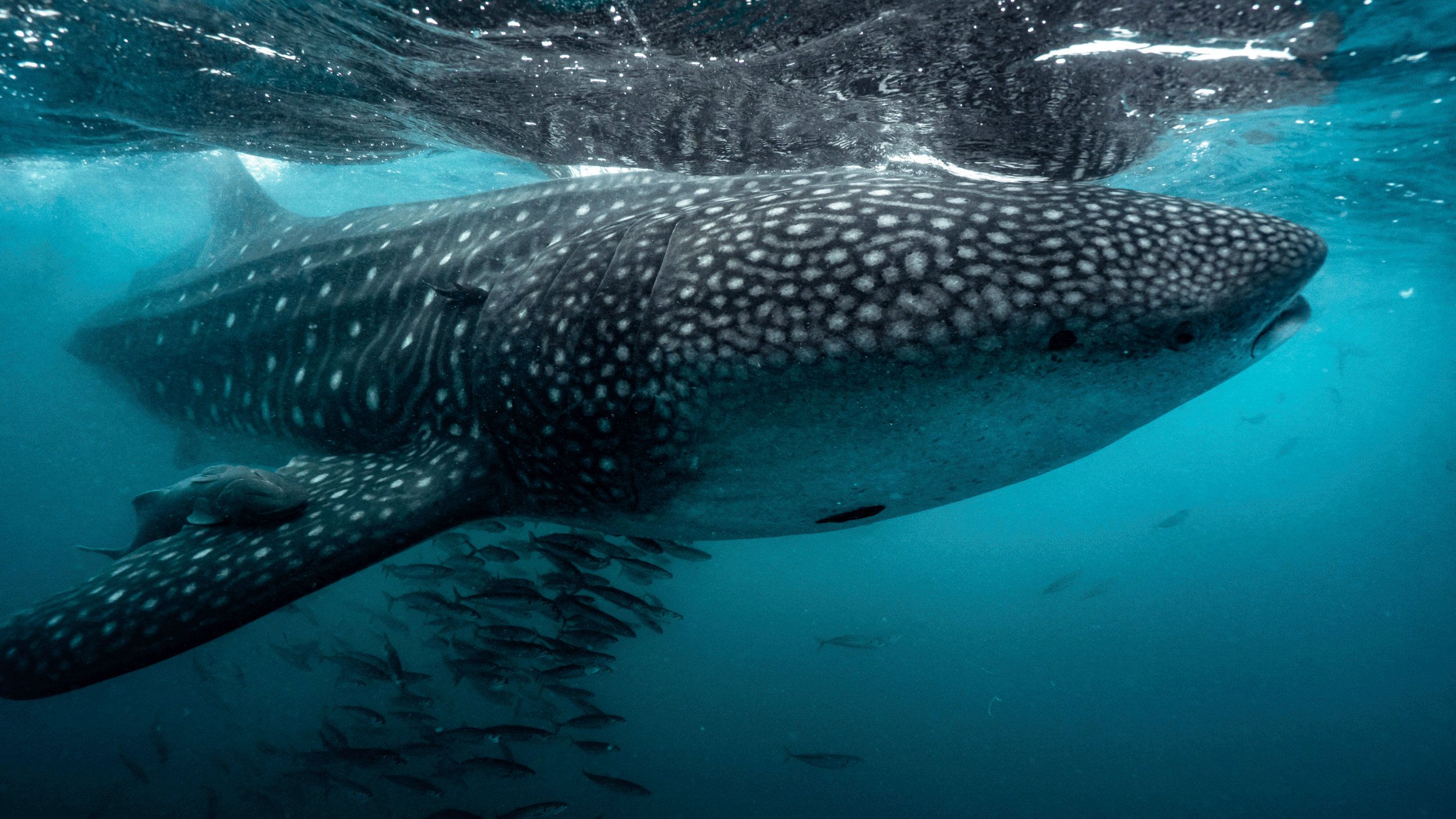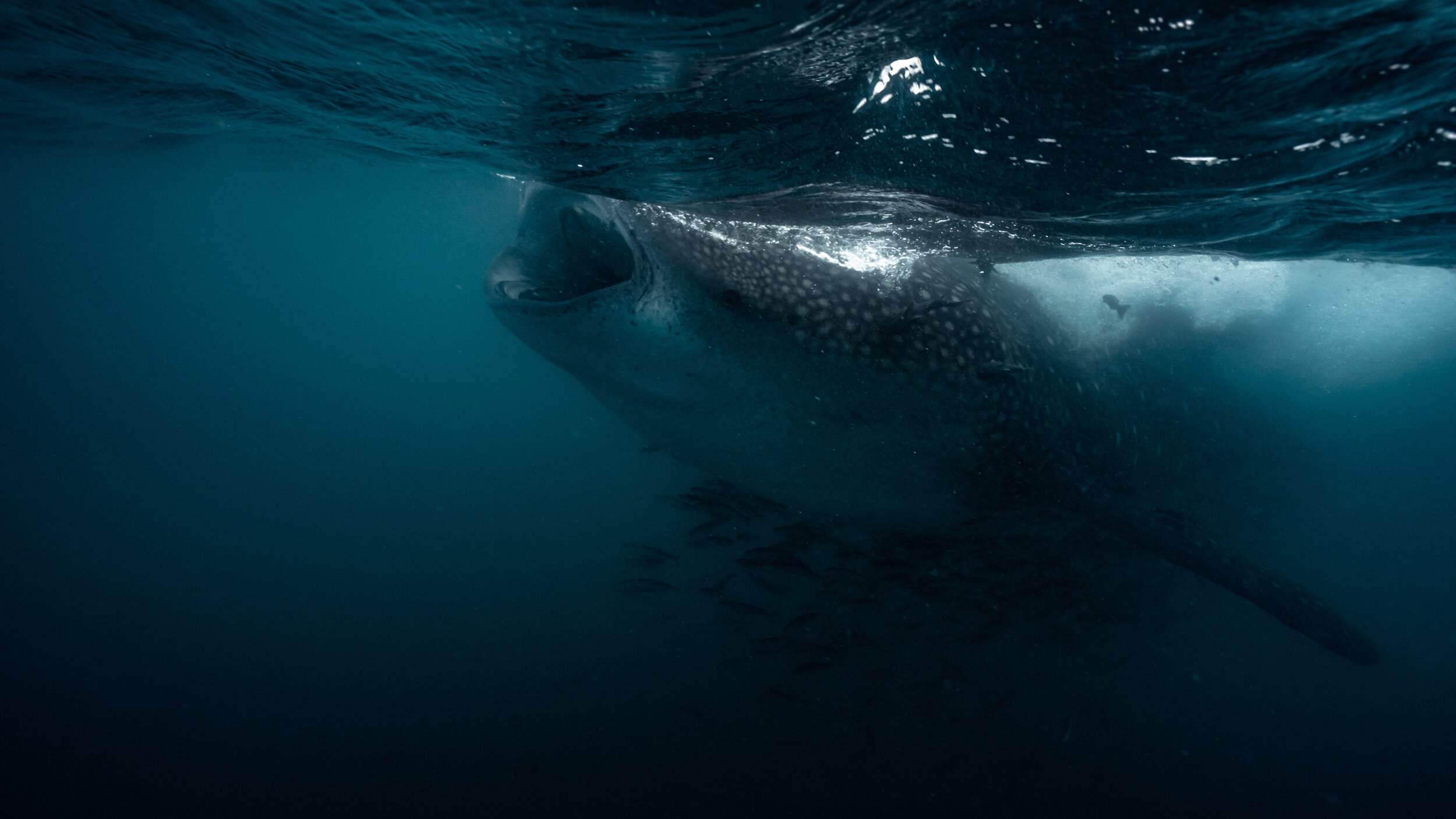
RAISING WHALE SHARKS
Exploring the Marine Feeding Grounds of Juvenile Whale Sharks
SEA OF CORTÉZ, MEXICO
Tucked away in a calm bay in Mexico's Sea of Cortez, large numbers of juvenile whale sharks spend their growing years here re-entering the open ocean as sexually mature adults. The reason they stick around this area for so long is the abundance of plankton, their primary food source. Being one of the windiest areas in Mexico, strong gusts concentrate the plankton in several bays along the Baja shoreline, providing a nutrient rich home for hungry, growing whale sharks.

Feeding Time
Sea of Cortéz, Mexico. December 2020.
A large (7 metre) juvenile whale shark feeds by opening its large mouth and skimming the surface of the water for plankton. While whale sharks have teeth, and lots of them, they don’t use them. Instead, they feed by filtering water through their mouthes and catching small plankton on a net like receptor in their throats.

Remora and Sardines
Sea of Cortéz, Mexico. December 2020.
With so much plankton in the water, the bays along the Sea of Cortez attract many other hungry fish. Seeking protection from more aggressive predators, sardines travel in schools underneath whale sharks, while remoras cling onto their much larger cousins, picking off particles from their skin to eat.

Seeking Shelter
Sea of Cortéz, Mexico. December 2020.
A school of sardines swims under a whale shark in the Sea of Cortez. The sardines are also attracted to the water due to the abundance of plankton, but they fear larger predators. So they swim in small bait balls just under and alongside whale sharks to avoid detection.

Big Gulps
Sea of Cortéz, Mexico. December 2020.
Taken just inches from the whale shark’s mouth, this image shows how they feed up close and personal. The water here is thick with plankton, and the whale sharks open their gigantic mouths and gulp down water, feeding and filtering it furiously as they swim along the surface.

Wide Mouth
Sea of Cortéz, Mexico. December 2020.
Whale sharks’ mouths are wide and narrow, allowing them to swim easily through the water when they want to swim, while also allowing them to take in an incredible amount of water when feeding. As sharks, they have plenty of sharp teeth in there, but they do not use them. Rather, whale sharks filter their food on net like structures in their throats.

Swimming Whale Shark
Sea of Cortéz, Mexico. December 2020.
A large juvenile whale shark swims with its dorsal fin above the water in the Sea of Cortez. The easiest way to spot whale sharks, especially in this low visibility water, is by spotting their dorsal fin sticking out of the water.

Rising from the Deep
Sea of Cortéz, Mexico. December 2020.
As the sun warms the surface of the ocean and allows plankton to bloom at warmer, well-lit areas of the water, whale sharks rise from the deep in order to feed.

Along for the Ride
Sea of Cortéz, Mexico. December 2020.
As the sun rises further towards noon, heating the water even more, the whale sharks become increasingly active with their feeding. Joining them comes remora fish and sardines.

Gliding just under the Surface
Sea of Cortéz, Mexico. December 2020.
Despite their size, whale sharks are very stealthy swimmers, much like their other shark cousins. Generally show, they can definitely put the peddle to the meddle if they feel threatened, moving their large tails from side to side to propel their bodies through the water.

Picture Perfect Whale Shark and Sardines
Sea of Cortéz, Mexico. December 2020.
A large 7 metre juvenile swims by accompanied by a small ball of sardines under its belly. Not at all like whales, whale sharks are very much sharks. They also do not react much to human presence in the water, whereas whales and even several other species of sharks have a more distinct reaction to humans.

The Eye of the Whale Shark
Sea of Cortéz, Mexico. December 2020.
Whale sharks have distinctly “fishy” eyes about the size of a large grape. While their bodies are enormous, their vision is not that great, and their eyes are located all way way on the corners of their head.

Watch the Tail
Sea of Cortéz, Mexico. December 2020.
Whale shark’s large tails are used to propel them through the water. They move their tails from side to side to generate power, much like sharks, but they have a lot larger of a body to maneuver. They pack a lot of power in their tails, so definitely keep a safe distance away.
